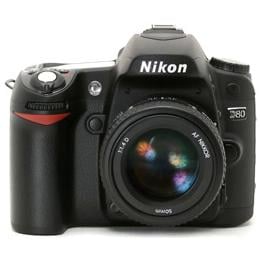nikon d80
Nikon D80

Nikon D80 setup instructions for stop motion animation or time-lapse photography with Dragonframe
Supported Versions
Requires Dragonframe 2.3.8 or newer. (3.x, 4.x, 5.x, 2024.x are newer).
Live View
The Nikon D80 does not provide live-view. You have two options for using this camera with Dragonframe:
- Use a separate video camera or USB camera to provide live video.
- Work without live video, capturing 'preview' frames instead. (See User Guide in Help Menu).
Camera Settings
Dragonframe controls the Nikon D80 ISO, shutter speed, aperture (with digital lens), image quality, and size.
Product Info
You can find the Nikon D80 manual and specifications at the Nikon website.
Manual Lens to Avoid Flicker
To avoid any potential flicker that can be caused by electronically controlled aperture lenses, please consider using a fully manual aperture lens.
Learn More about Aperture Flicker
Setup Instructions
- Create a new scene or open an existing scene. (Dragonframe will not connect to your camera unless you have a scene open.)
- Power your camera by AC power if possible, or use a fully charged battery.
- Close any other applications that might connect to your camera.
- - For macOS, Open Image Capture, select your camera, then in pop up area in lower-left select Connection camera opens: No application. (See Picture)
- Make sure Dropbox is not a client of the camera.
- You may need to quit Google Backup and Sync, since it can interfere with the camera even if you turn off syncing.
- If you have anti-virus software, white-list Dragonframe so that it may access your camera.
- Set the Mode Dial to Manual (M).

- Set Auto Image Rotation to OFF.
- If you use a Nikon digital lens, set Lens to Manual Focus and disable Vibration Reduction.
- You may need to remove the camera's memory card.
- Set USB Mode to PTP.
The camera will not connect unless you do this. - Set Active D-Lighting to OFF.
- If you need to use a flash/strobe, you must set Silent Live View Photography to OFF.
- Connect your camera to the computer with an appropriate USB cable.
- Proceed to the Cinematography workspace to adjust the camera exposure settings, check focus, and take test shots.
